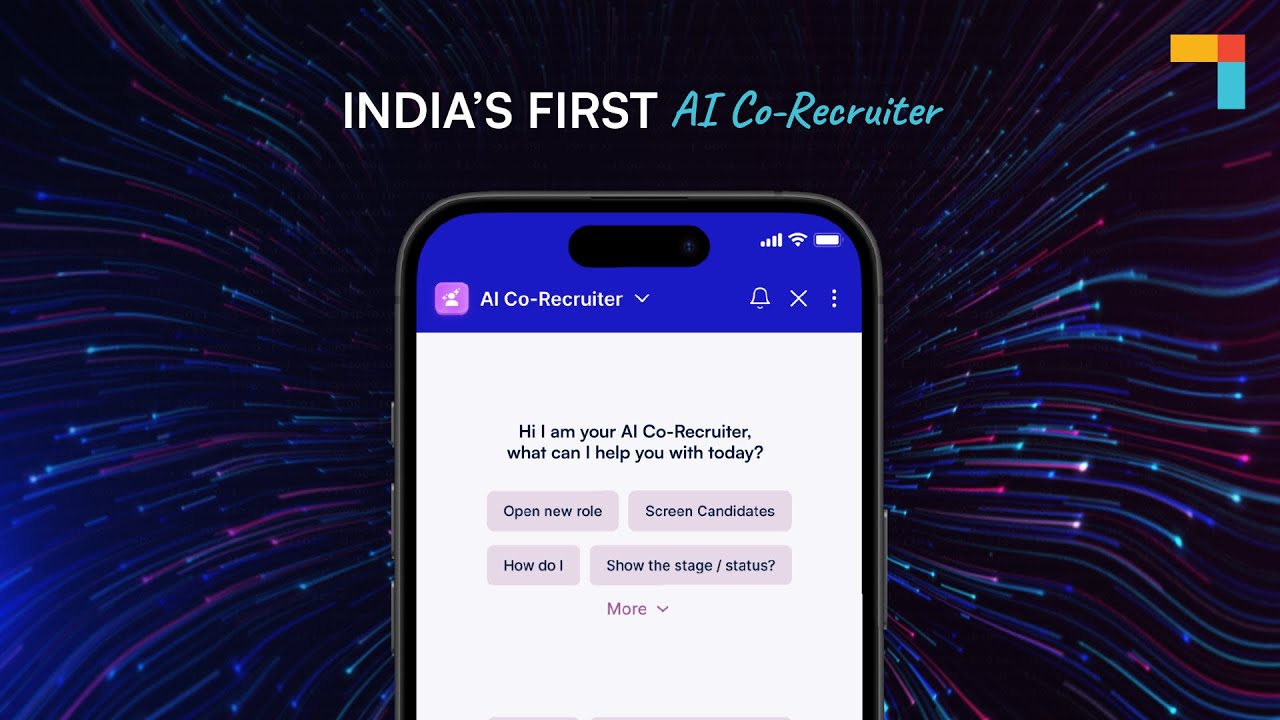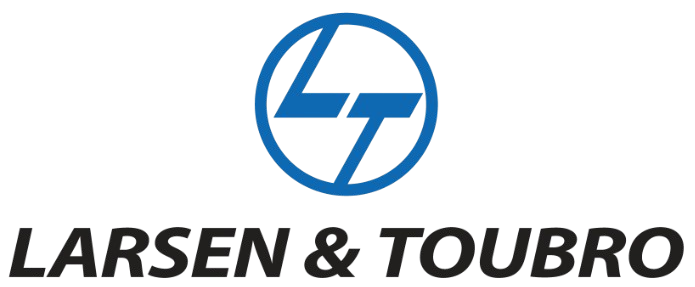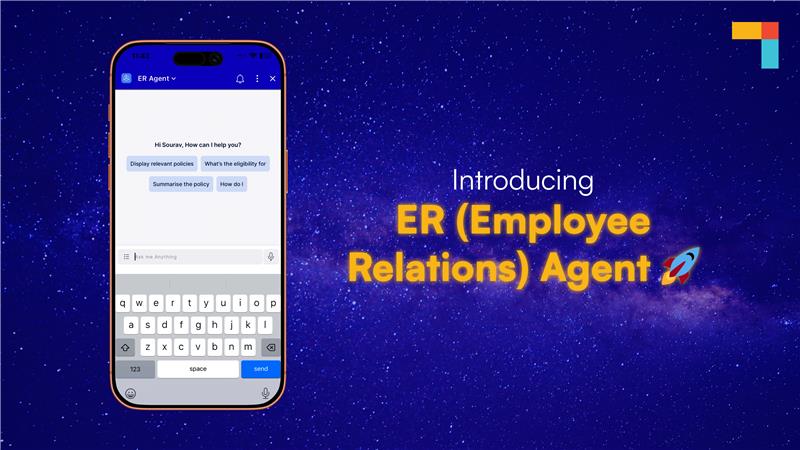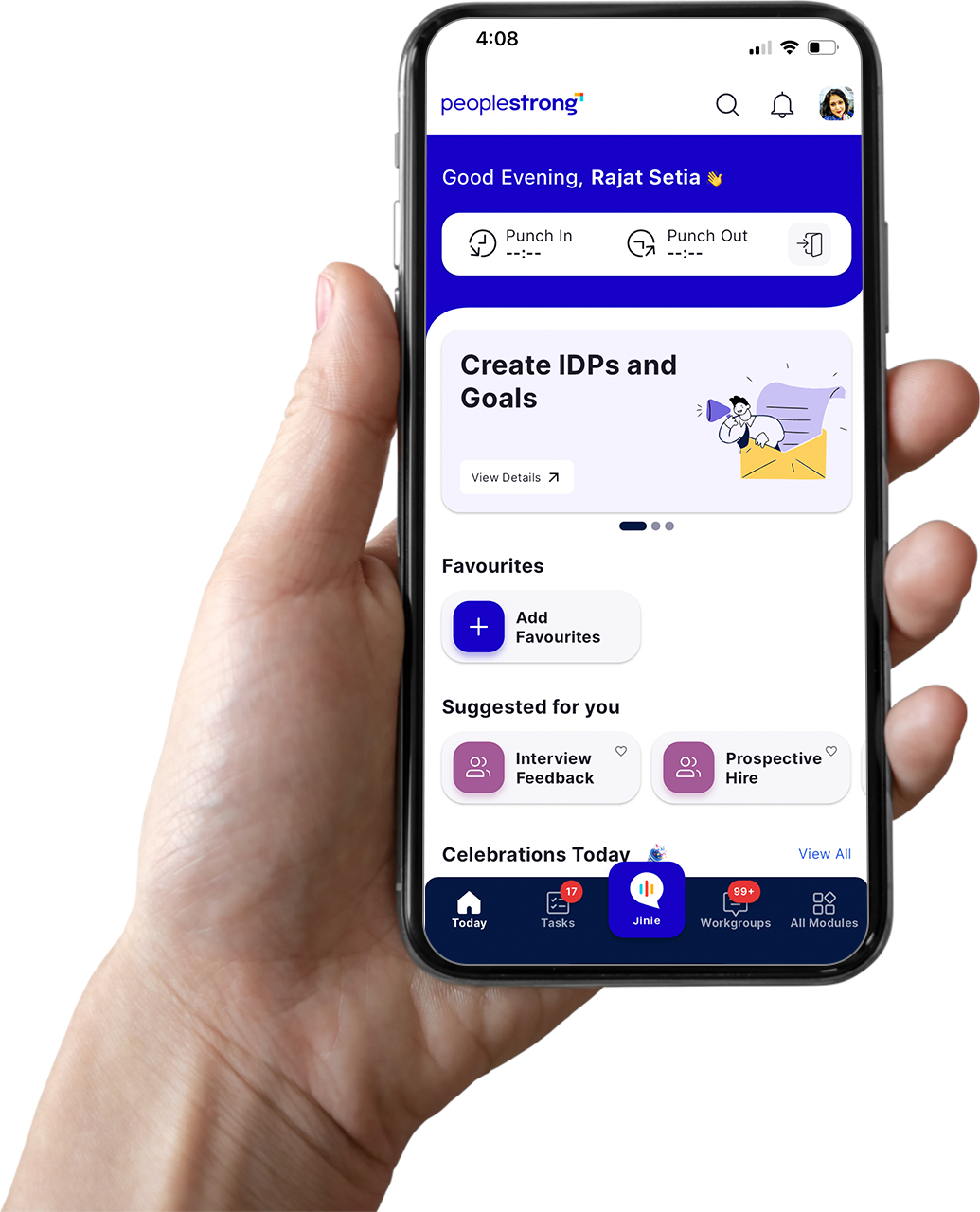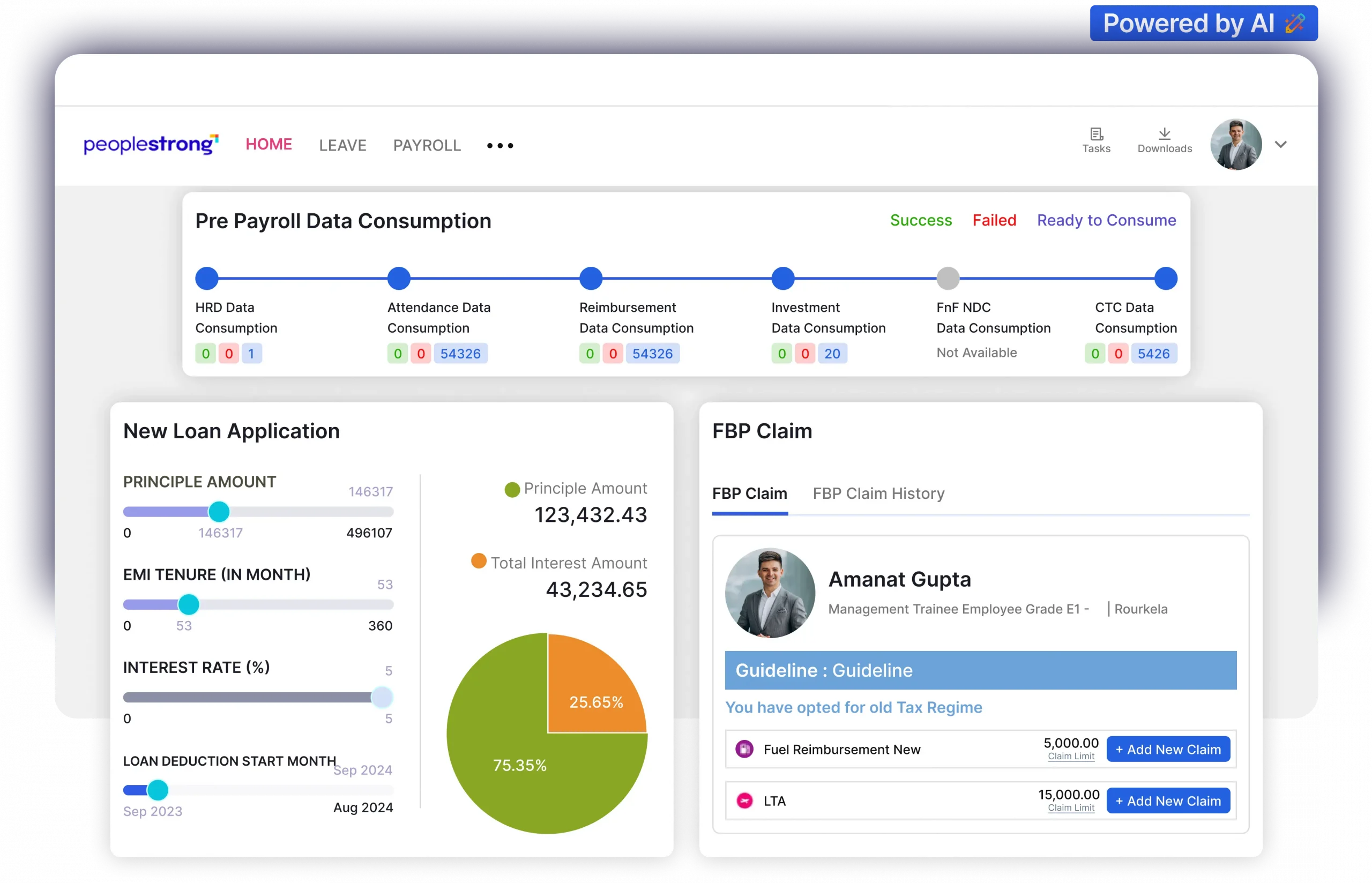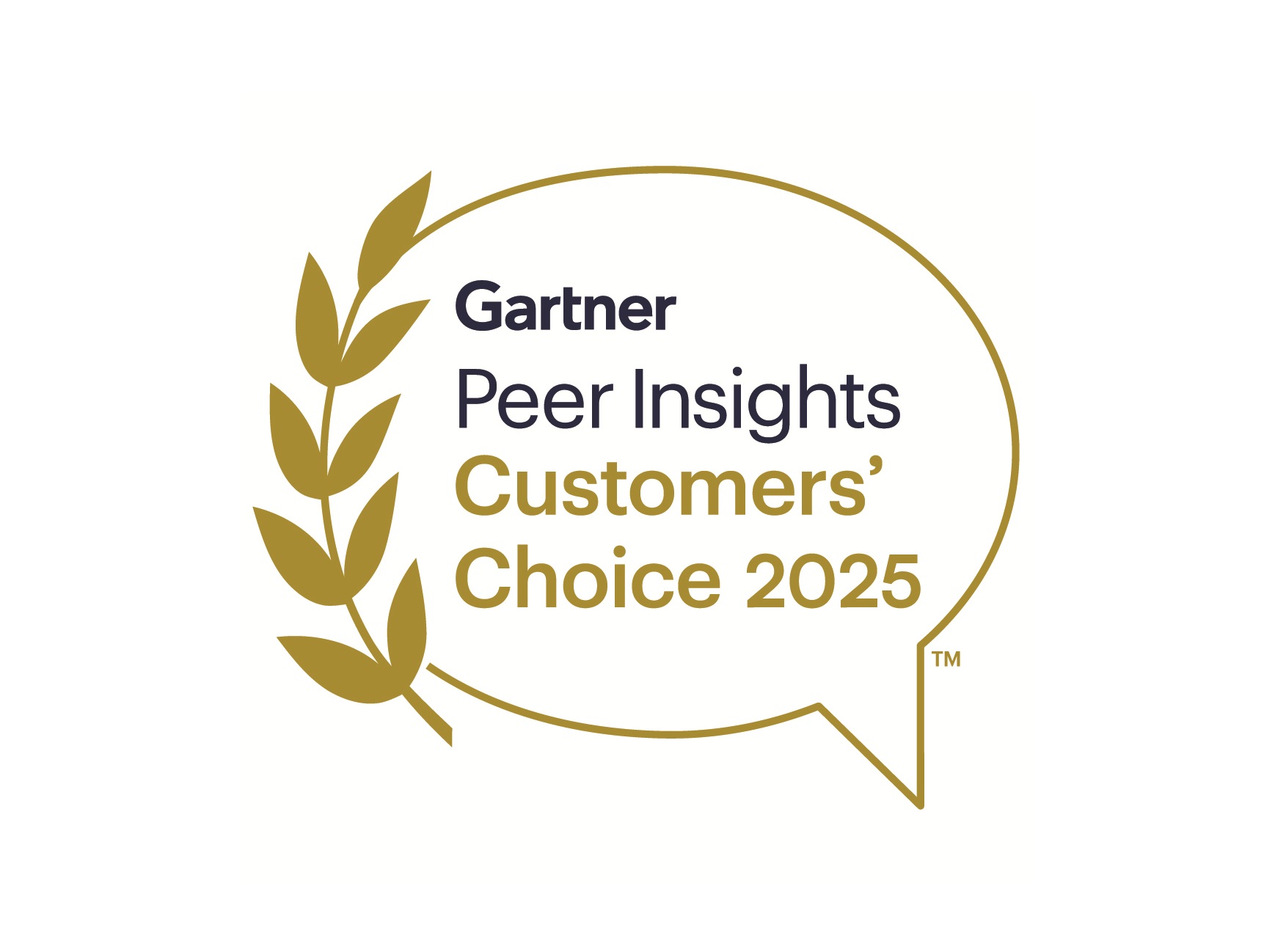About 48% of employees across the world are watching for or actively seeking new jobs elsewhere at any given time, according to Gallup’s 2024 global workplace report. With fierce competition in the talent economy, talent crisis, and a fleeting workforce, you need to provide a healthy, positive, growth-oriented environment to your people from day one, to attract and retain them in your company.
That’s why a good talent management process is essential for any company and a main area of concern for all HR professionals. Keeping talented employees interested in working for the company despite the cutthroat competition in the market, by offering them a safe, rewarding, and challenging environment to grow is the crux of talent management, but it’s easier said than done.
In this guide, we’ll take you through A-Z of talent management, so you know where to focus your HR process improvement efforts.
What is Talent Management?
Talent management is an overarching approach to finding, hiring, engaging, growing, learning, developing, and retaining top talent in your company. It stems from business needs, and long-term people strategy and trickles down to day-to-day practices that keep engagement, delight, and productivity in check, so your employees want to grow in your company, and others tap into their potential and dig deeper into what they’re capable of.
Without a robust talent management strategy and process in your company, you won’t be able to attract the right candidates, lose the best talent to competitors, see no follow-through on your employee engagement initiatives, and face a plateau or decline in the adoption of even your best-performing ones.
Why is Talent Management Important?
According to Gallup’s 2024 global workplace study, 14% of the workforce around the world is highly engaged. 61% are not engaged and about 15% are actively disengaged. Of these employees, those not engaged can be turned into champions of your organization with the right talent management initiatives. 67% of people leaders assert that their talent strategy is integrated with the business strategy, and only one in three businesses have fully digitized talent operations. This is one of the reasons talent management is crucial. Without it, deadlines aren’t met, gossip and morale issues prevail, internal conflicts arise, and management issues pop up.
Quiet quitters in your organization will also give the workplace another chance if they want to see refreshing changes in the working style or environment. An increase in engagement initiatives, as part of the talent management strategy, has 3.8 times as much influence on employee stress as much as work location, so revamping your talent management efforts is sure to yield great results.
When talent is celebrated at all levels, the heartwarming changes also happen:
- Internal talent mobility increases
- Employee experience gains importance, and you witness boomerang employees
- Organizational flexibility improves
- Job satisfaction and employee value proposition show improvement
- You attract A-list talent easily and reduce talent acquisition cost
- You deliver the right people at the right time for the right project
- More employees realize their full potential
- You create dedicated, and talented leaders who will keep the company running for years to come
What Problems Do Enterprises Face in Maintaining a Robust Talent Management Process?
Setting up and sustaining talent management becomes a mammoth task when the employee strength is huge, like in an enterprise. The following common problems come up:
- Simple processes become overly complicated and people lose sight of why they started doing it in the first place.
- A culture of entitlement in the organization – just because an employee was successful in the past, their performance is deemed to be high even if there’s actual proof of underperformance.
- Too many steps in every HR process mandate them to spread their bandwidth thin
- Some processes may be redundant but followed just because it has been followed for ages
- Managers and decision-makers don’t know how to use the data they have for coaching their people
- Talent management tools and processes may not meet day-to-day challenges and can be too theoretical
- Lack of transparency and accountability in evaluation
- Thinking all employees are performing well
- Managers and leaders don’t give and take feedback regularly, since they think they have more important things to worry about
What is the Talent Management Process? + Best Practices
Martin G Moore, an international business coach and high-performance leadership coach says,
“ Taking what you know about your people’s potential and capabilities, and marrying that with your organization’s view of which skills are required gives you a comprehensive approach to talent acquisition, management and development. “
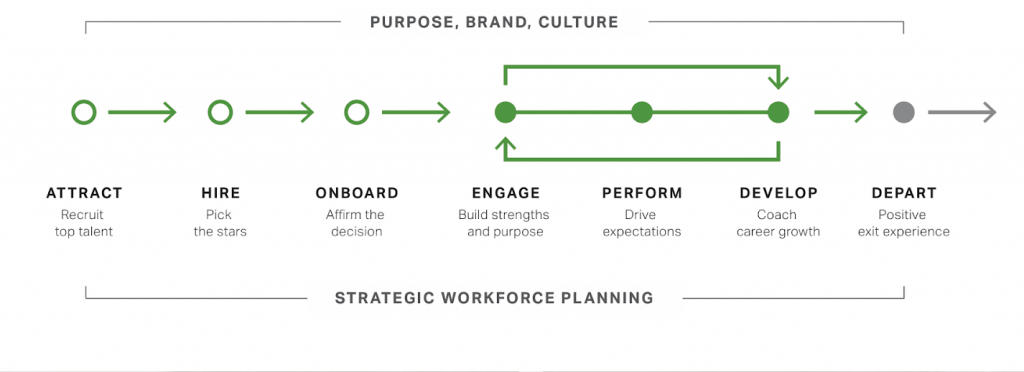
Source and Attract the Right Talent
1. Create employee personas
Depending on where you want your business and people strategy to be in the next 3-5 years, and what you want to achieve by then, you identify the people who can get you there. Craft employee personas to help you hone in on what exactly each role and designation should do.
Take lists of consistent high-performers, and high-potential employees over the years and see what they have in common. These are people you want to have more of and the kind you desire to attract to your company. Make personas of these people – where did they study, what companies did they work in, what skills do they have, etc.
When done for a whole function, you’ll have a set of functional, behavioral, and cross-functional competencies, skills, and desired behavior you want in the employees who will fill those roles. These are your ideal candidates, and this is where your recruitment plan, as part of your workforce plan starts.
2. Hire the best skill and cultural fit
Now that you have the right persona in place, see where these target candidates interact, places they consume information, exchange ideas, and form impressions. This is where you scout for talent, and position yourself as the best employer. Find sources that have direct access to these target candidates – agencies, headhunters, educational institutions, forums, communities, etc, and position your employer brand.

You can’t always find a 100% match, but find a middle ground in a person who has most of the desired hard skills (job-related skills) and all the soft skills (behavioral traits) you want for the position. In all your interactions with them, subtly assess their cultural fit to your company, and make every touch point meaningful. In the interview stage, get into a career-coaching mode instead of an interview mode, so it helps the candidate think about their priorities, learn about the process, and think about how your position helps them.
3. Giving a stellar candidate experience
Right from the time you contact them, till you onboard the right talent, ensure they’re engaged and know what they’re committing to. Most organizations miss out on engaging the candidate during the preboarding stage – the time between accepting the offer and joining the company. Showing you look forward to having them onboard, making sure the transition from their previous organization is smooth, and helping them ease the transition to your company (relocation, finding accommodation, commute etc) will show the candidate you care about them as a person, and as a professional, and they will be ready to go the extra mile for you.
But, the catch here is when you hire in bulk, it can be almost impossible to keep track of all candidates and contact them. That’s why you need PeopleStrong to ease candidate communication by connecting your recruitment module to WhatsApp, and ensuring all candidate-related information is stored and accessed from one common source.
Amara Raja, India’s largest automotive batteries and allied products manufacturer with 15,000+ employees across the country wanted to move from relying on different tools for different HR processes, on email for communication to one portal that served as the single source of truth, and for all HR processes to be managed. When it came to recruitment, given their large scale of operations, they needed a steady inflow of talent as and when required, so processes had to be made efficient.
PeopleStrong understood their need, and implemented our suite of HR tech tools in a super-short period, which resulted in a 35% increase in process efficiency and a drop in the recruitment timeline for a position from 16 hours to 6 hours – all recruitment operations, including candidate engagement made easy and effortless, resulting in a 91% increase in overall productivity.
Help Talent Align With the Organization’s Goals
4. Set goals and performance standards that contribute to your overall goal
In his book ‘75 Ways for Managers to Hire, Develop, and Keep Great Employees’, Paul Falcone, best-selling author and ex-CHRO of MPTF says,
“Most new hires failures are not a result of a technical mismatch, early turnover typically results from a difference in core values about leadership, communication and expectations regarding teamwork.”
Create an effective onboarding process that inducts the new hire into your organization while promising a strong support system for them to work and grow. Link the connection of the employee’s responsibilities to your organization’s big picture. When employees see the ripple effect they have in your company, their accountability increases, and they become productive and engaged with their jobs.
5. Model expected behavior and appreciate any such instance
Show your employees what you value and emphasize, that the means to the goal is as important as the goal itself. Most organizations only want their employees to meet their targets, but growth is beyond just that.
It means exhibiting leadership behavior and contributing to a healthy work environment by looking out for one another. Measure instances where your employees show camaraderie, trustworthiness, team spirit, etc, and offer public appreciation for any instance of expected behavior.
Nurture Employees to Upskill and Evolve

6. Bring in multi-faceted learning and engagement opportunities
One of the most important things senior executives, middle managers, and front-line supervisors face is inspiring and motivating their teams. In light of changing priorities and demands, how do you ensure they stay motivated and align their priorities with yours?
It’s the manager’s duty primarily, along with the HR team to create an environment in which employees can motivate themselves, and this involves recognizing hard work, rewarding desirable behavior, recording critical incidents where employees display exceptional talent and initiative, and nurturing them every step of the way.
Every employee needs to have a healthy balance of 5 components to be engaged in their job – environment, relationship, support, growth, and compensation. When all these aspects are consistently fulfilled, the employee is more than likely to stay committed to the organization, and actively decline recruiting calls from competitors.
7. Present challenging projects that make room for growth
New-age workers, regardless of which positions they’re in, want to win. Teach them how to do it right, and give them opportunities to prove themselves. With the right support, challenging projects will bring out the best in your people. Anyone placed in an unfamiliar environment will come across a point where they experience hopelessness, fear, and frustration. When your managers are there right beside them to guide and inspire, this adverse state quickly turns into engagement, improved collaboration, connection, idea sharing, and psychological safety.
Assess Employees on Their Performance and Potential

8. Compare employees’ performance vs potential
Most managers misunderstand the key strategies behind using performance management and reviews as motivational tools for employee self-development.
Performance is a combination of three components:
- Employee behavior, how well they lead, manage, collaborate, and set standards for other team members, and to what standards they hold their work.
- How committed are they to your company values?
- How well do they achieve targets and critical objectives?
Once you iron out the performance data and potential, see which employees stand out in all those criteria, take time to talk to them individually, have their managers talk to them, and identify which career paths each one wants to take.
An extension of the 9-box grid, the following important types of categories of employees are to be considered carefully, to make or break your organization’s future.
Not everyone wants to climb the corporate ladder instantly. Depending on their potential, current performance, and organizational needs, you figure out how to proceed. It’s an entirely evidence-based discussion.
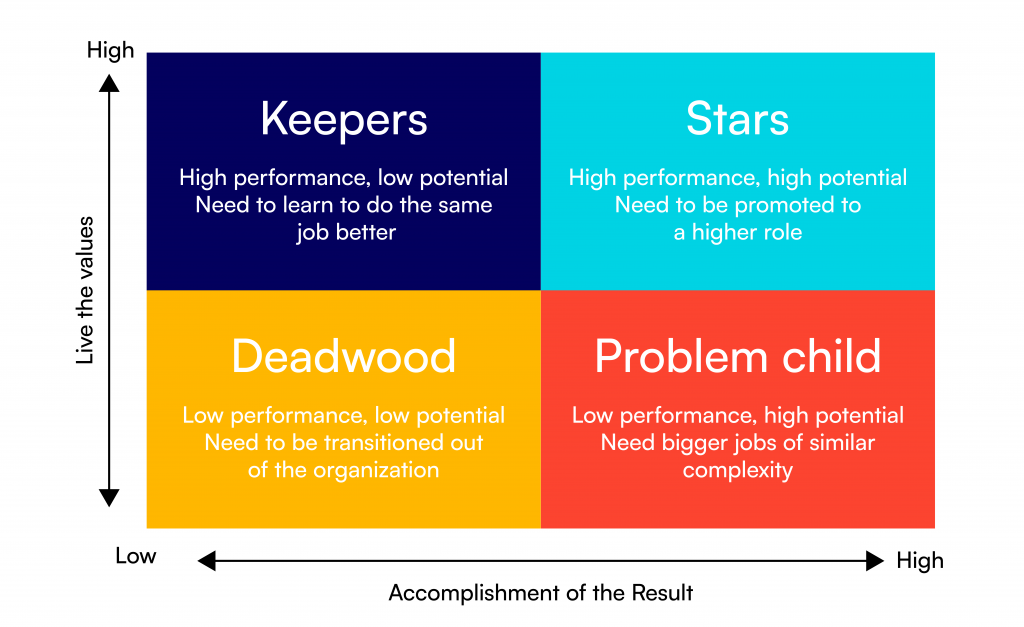
Performance reviews can be a particularly hard time of the year, for any team, especially for large enterprises with thousands of employees. Flydubai, a renowned high-quality, low-cost airline, with 5,000+ employees cut down their long-drawn performance reviews spanning over months to a simplified review and completed the entire process in 12 weeks, using PeopleStrong.
About 80% of employees created objectives in 3 days, and had their reviews done, without much intervention by HR. We ensured they had easy and complete data-flow from their previous tool, quick log-in, and single sign-on capability. We automated Flydubai’s review process 100%, which immensely reduced the HR team’s workload.
Suggested Read:
The Ultimate Guide to Performance Management for HR Leaders
9. Give and take feedback regularly
A one-time performance review is slowly becoming a thing of the past. Companies are moving to more agile performance reviews, say quarterly, or half-yearly reviews. Frequent feedback sessions (formal and informal), and course correction are critical to ensure employees are engaged and are performing to the best of their ability.
As humans, we have the need to feel seen, heard, and belonged. Having frequent feedback meetings helps meet all three needs, and to remind the employee that they have a strong support system to fall back on. Gallup survey says 84% of employees who receive feedback on the go (fast feedback) are highly engaged, and 19% of employees who didn’t receive any feedback whatsoever are actively disengaged.
Propel Employee Growth and Development

Martin G Moore, an international business coach and high-performance leadership coach says,
“ You have to have the culture, not just the processes to rigorously manage the talent you have. This means your leaders have to value their people and differentiate between those who perform and those who don’t.”
Success, as an organization, will entirely depend on the talent you have in your team. If you have people who meet or exceed expectations in their current job role, you may want to train them for future leadership responsibilities.
10. Carve out a personalized development plan
Most performance reviews end with a monetary enhancement, a promotion, or both, but often don’t follow up on developmental goals.
Identify the growth pattern each key role has to take, to cater to the organization better:
- Which roles do you need to put your best people into?
- Who holds critical IP in the organization?
- Who needs to be trained in a core discipline so you don’t lose out on corporate memory?
- What are the opportunities for cross-skilling to ensure you don’t have a single point of failure?
Once you have answers to these questions and have carved out the growth trajectory for each band and grade, the next thing to do is ascertain what your employees’ personal aspirations, preferences, potential, and learning goals are, so you can carve out their development plan. Doing so, you’ll also cater to the succession planning for your organization.
Ensure Respectful Exits
An employee leaving doesn’t mean the organization should burn bridges with them. They are assets who have worked for you, and they can still yield good returns for you by sending good talent your way, helping you out with referrals, and spreading goodwill they hold for you if the organization treats them right on their way out.
Offboarding is as important as onboarding, and in some ways more crucial. Form an alumni network and keep your ex-employees close. They can be silent advocates for your company’s growth and may even come back as boomerang employees to work with you again.
How to Create a Talent Management Strategy Step-by-Step?
The most important question the talent management team needs to ask and the answer is, “Who are your most talented employees and what do you do with them?”. Developing a talent strategy based on your employee persona, and crafting talent management processes with your strategy as the base would help you answer that question correctly.
1. Need analysis/pulse check
Administer surveys, and quick pulse checks to determine what your employees feel. People need to feel they’re working towards their own personal vision, so we need to find out what’s important to them, so they know their company cares about them.
2. Evaluate your current HR processes
From the survey results, find the #1 unmet need for your employees and make it your priority to build the particular aspect of employee experience from there. Assess the impact your current human resource process is creating, and compare it with the desired benchmark. For example, if you have a 1-way performance review right now and your employees say they don’t feel like their voice is heard, consider bringing in 360-degree feedback, or at least a 2-way review, so the employee gets a chance to voice out their concerns.
3. Create a strong employer brand
An employer brand is closely linked to your EVP and how employees feel about being associated with you. Improve your brand presence by showcasing what existing employees feel about your organization.
It can be in terms of ‘A day in the life of…’ videos and posts on social media, showing how you work, work-life and benefits you offer, your culture, etc, and heavily on what your employees share about your company on social media. Instead of making it mandatory, make the rewards and employee experience exhilarating so that employees want to show off what they have with them to the world.
4. Nurture your employees holistically
Stephen Covey says when we draw points from the emotional bank account, and never put in any points in it, people feel bankrupt. We need to put it in and acknowledge people for what they’re doing right. This is why recognition and growth are important, at all phases of the employee lifecycle. It’s not about plugging in wellbeing or engagement initiatives once in a while during the lean season.
It’s about treating engagement as important as work and planning work around it. They go hand in hand, are your engagement calendar is planned in advance, so nothing goes amiss. Make nurturing and growth a part of your culture, so people know it’s not a one-time thing, and the future of talent management of your company is insured.
Managing all aspects of employee engagement, tracking their progress, and making changes on different tools can certainly drain your energy. You need a robust, intelligent tool to take care of engagement, with functionalities that can match the volume demands of an enterprise and a sporadic workforce.
That’s where PeopleStrong comes in. For Hanu, we implemented an entire employee engagement suite in less than 30 days, and witnessed a 6% improvement in the bottom line, along with a whopping 90% boost in employee engagement.
How Can PeopleStrong Help?
Given how critical the talent management function is, you need a team of seasoned experts to help you brainstorm HR process improvement, visualize the ideal employee lifecycle you want to create for your workforce, and show you the infinite possibilities you can have with the help of technology.
Mrigank Tripathi, President of Growth at PeopleStrong says a comprehensive HCM can give you a superlative employee experience, by aligning your implementation outcomes with your vision.
Before we kick off any project, we assess the following parameters, that’ll help steer our project toward success:
- Organization design
- Business readiness to change
- The potential impact of the proposed change
- The time it’ll take for the organization to realize benefits
- Communication patterns within the company
- Executive alignment and level of leadership buy-in for the digital transformation project
We take every step of our 8-step implementation process seriously. We fall back on our decades of collective HR experience to deliberate, brainstorm, experiment, and implement the best solutions for you. Our all-encompassing, hire-to-retire solution is tailored to the T for your organization, during implementation.
Your digital transformation journey doesn’t have to be hard. 53% of HR leaders say mitigating change fatigue is a top priority. With the PeopleStrong Talent Management Software and our unparalleled implementation, you only have to change once, to cater to the present and future generations of employees. We’ll make this one change smooth, cost-efficient, and quick for you.
Get in touch with our sales team to schedule a quick demo today, and implement our robust talent management module.
Empower your workforce with PeopleStrong's Talent Management solution, designed to nurture growth and drive performance. Leverage comprehensive tools for goal-setting, performance tracking, and learning and development. Enhance employee engagement and unlock your organization's full potential. Experience the impact of PeopleStrong's Talent Management — click below to schedule a personalized demo today.
Contact Us Now